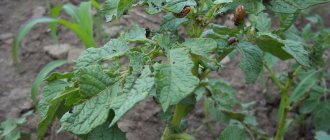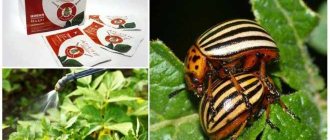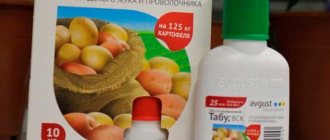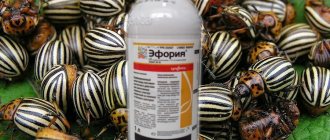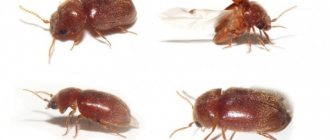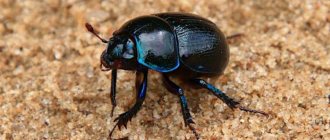All gardeners have at least once encountered such enemies of potatoes as the Colorado potato beetle. You can fight them using chemicals, or you can create natural enemies of the Colorado potato beetle.
The Colorado potato beetle doesn’t have many enemies, but you shouldn’t sit back and wait for this pest to ruin the entire harvest. This article will focus on those birds and insects that eat the Colorado potato beetle.
Who eats the Colorado potato beetle? The main natural enemies of the pest
Who eats the Colorado potato beetle?
In domestic latitudes there are birds and insects that act as natural enemies of this pest. For example, it is known for sure that guinea fowl eat Colorado potato beetles. In the southern regions of the planet there are many more animals that can help in destroying the parasitic insect.
However, we will not talk about this in this material, since their use in our conditions seems impossible. Let's look at who eats the Colorado potato beetle in the current climatic conditions.
Do guinea fowls eat insects?
Don't be skeptical about the fact that guinea fowl eat leaf beetles, it's true.
The feathered “special forces”, walking along the rows of potato plantings, will destroy not the adult striped pests themselves, but their larvae and egg laying.
It is enough to release feathered birds into the garden 3 times - and not a trace will remain of the garden pest.
There is, and the main disadvantage is that Guinea chickens are very shy birds. It is enough for someone to scare them, and they immediately begin to “bawl.” Frightened, they can fly to a safe place and return home only in the evening.
Read more: What birds eat and peck rowan in winter
Lacewing
If we talk about who eats the Colorado potato beetle among insect representatives, we cannot ignore the lacewing. In appearance, it resembles a small dragonfly of a light green color.
The lacewing is a predator. The insect is known for its gluttony and unpretentiousness in choosing food. The lacewing can help in destroying clutches of eggs and recently hatched larvae of the Colorado potato beetle. Due to its modest size, it is not able to influence adult, mature pests.
The insects known locally as hoverflies are predatory flies. Like ladybugs and lacewings, syrphids are one of the main natural enemies of this pest.
Hoverflies do not reach the size of an adult Colorado potato beetle. Therefore, they are absolutely useless in the fight against large individuals. However, their spread on a plot of land during the formation of pest larvae can significantly reduce its population.
Who eats the Colorado potato beetle among other poultry? Pheasants cope well with this task. For these purposes, they are walked around the plot in the first half of summer. It was at this time that a massive increase in the parasite population was observed.
Breeding pheasants makes it possible to cope with the extermination of a number of other harmful insects, in particular, the larvae of the cockchafer and the mole cricket. At the same time, these birds are quite picky about their living conditions and do not always survive in harsh domestic winters.
edit Cultural
Monument to the beetle in Berdyansk, Hochland. Actually it's in the lower right corner
In yard poetry (sung to the tune of the song “Hafanana”):
| The sun is shining. The meadow is turning green. The Colorado potato beetle walks across the field. He still doesn’t know about everything that a rural agronomist will catch him, put him in a jar, tear off his legs, unscrew his head, and the bug will die. The bug will cry, shed tears, And his bugs will sing: Malyana-nikalana, scorch Kalya. She was fumbling and crowing, being naughty. |
As an option (sung to the tune of “Oh, the viburnum is blooming”):
| The sun is shining. The meadow is turning green. A Colorado potato beetle walks across the field. He devoured the potatoes and began to eat the onions. What a bastard the Colorado potato beetle is! He still doesn’t know anything about the fact that the uncle-agronomist will catch him, put him in a jar and fill him with shit. What a bastard this guy is an agronomist! And the bug will cry at night, the children will cry, they will call for the folder. The beetle will return home, sit by the window... It’s not easy to wash off that shit! |
Another option to the tune “Oh, the viburnum is blooming” (from a children’s TV show):
| Oh, the potatoes are blooming, the meadow is turning green. The Colorado potato beetle creeps along the leaf. He crawls, knows nothing about the fact that he will be caught by the agronomist. He will catch it and bring it home. He’ll put it in a jar and pour it with alcohol. The potatoes have bloomed and the meadow has been mowed. The Colorado potato beetle is running wild in a jar |
From the notebooks of Venedikt Erofeev:
| If in 45 we had moved further to the West, reached the westernmost states of the USA, then, like Suvorov-Rymniksky, Potemkin-Tavrichesky, Dibich-Zabalkansky, Marshal Zhukov would have been called Zhukov-Koloradsky. |
And another boyan
| Hitler and the Colorado potato beetle are sitting in hell. Colorado beetle: - Why are you sitting here? Hitler: |
Is it possible to use domestic chickens to kill pests?
It is necessary to accustom chickens to eat insects from an early age, when chickens reach 3-4 months. During this period, the bird’s favorite food should be mixed with Colorado potato beetle larvae. Thus, the chickens will have not only a visual, but also a taste association of the pest with the food. Subsequently, the prepared chickens will independently move around the beds, pecking parasites from the tops.
What harm does
The insect and its larvae are extremely voracious.
They received the name “leaf beetle” due to their love of eating plant leaves. The diet includes: potatoes, tomatoes and other crops; they can also eat some flowers, for example, tobacco, petunia.
The beetle most often refuses the fruits and roots of the plant, since by its nature it eats exclusively tops and leaves. But even nature can sometimes be deceptive, otherwise it is impossible to explain the fact that some representatives do not refuse fruits and young shoots.
The larvae are much more voracious than the adults. They can completely destroy all shoots. When all the leaves are eaten and there are no whole ones, they go to eat the leaf pulp, this leads to the complete destruction of the plant.
Individuals that are in the ground eat tubers. Potatoes refuse to grow, and in the end bring a meager harvest or nothing at all.
Natural enemies of the Colorado potato beetle: who eats them
All gardeners have at least once encountered such enemies of potatoes as the Colorado potato beetle. You can fight them using chemicals, or you can create natural enemies of the Colorado potato beetle.
Related article: Spark from the Colorado potato beetle for potatoes: instructions
The Colorado potato beetle doesn’t have many enemies, but you shouldn’t sit back and wait for this pest to ruin the entire harvest. This article will focus on those birds and insects that eat the Colorado potato beetle.
It's all about solanine
Solanine is a very successful evolutionary achievement of potatoes as a plant. Thanks to it, potatoes protect their above-ground parts from insects (solanine has insecticidal properties, that is, poisonous to most insects).
But in the process of its evolutionary development, the Colorado potato beetle managed to adapt to this poison. Of all above-ground potato pests, it is the main one.
Solanine is poisonous not only to insects, but also to all animals, including birds and hedgehogs. Colorado beetles, which actively eat potato tops, are literally saturated with this poison and have a terribly bitter taste. That's why almost no animals eat them. However, there are exceptions.
Natural enemies of the Colorado potato beetle
Today, natural enemies can help in the fight against Colorado potato beetles. Insects that eat this beetle include: ladybug, lacewing, and syphridids.
As for birds, these include:
- guinea fowl;
- pheasants;
- partridge;
- turkeys.
Ladybug
The ladybug is one of the most common insects. Gardeners can thank her for the destruction of the Colorado potato beetle, aphids and many other pests that very often operate in gardens and vegetable gardens. But despite this, ladybugs will only help in the early stages, because they only eat eggs and small larvae. As for adults, they do not attract ladybugs.
Lacewings
Lacewings are also an insect that kills potato pests. This insect looks like a small midge. And it destroys not only the Colorado potato beetle. But, like the ladybug, the lacewing eats larvae and eggs. But you need to fight adult beetles using other methods.
These insects are also called hoverflies. These small predatory flies are capable of fighting the larvae and eggs of the Colorado potato beetle. These flies are small in size, but in the early stages they will be very useful.
As you can see, all insects that are natural enemies of the Colorado potato beetle will be useful only at the very beginning, until the eggs and larvae become adults. If you miss this moment, then the presented insects will be useless.
This bird is domestic. She is not fussy about care. They tolerate different temperatures well. For them it’s not scary either -50 or +40. In addition, guinea fowl lay eggs that are hypoallergenic. They can be eaten by children, as well as people on a diet. These birds do not rake the ground, but get the larvae from the plant. These birds are small in size, but they love to feast on Colorado beetles, so they are not afraid of even the beetle population. Guinea fowl eat both larval and adult beetles. In addition to ridding areas of pests and laying eggs, these birds provide tasty meat.
Important: if the area is 10 - 15 days, then 3 - 4 guinea fowl will be enough for this area to combat the Colorado potato beetle.
Pheasants and partridges
Very often you can see partridges or pheasants on the plots of summer residents. They help get rid of beetle larvae, and more. Like guinea fowl, these birds are undemanding in care and are not afraid of minor disturbances in maintenance and care. Pheasants sometimes have free range on the property. But they need to be monitored, because, in addition to the fact that they can feast on pests, they can also trample plantings and damage the crop.
These birds also eat Colorado potato beetle larvae, but require special care. They may be susceptible to various diseases. Therefore, when growing them, more care and attention are required.
Walking poultry should be done in June, because it is at this time that the beetle larvae are actively developing.
Feathered helpers
So, let's figure out who eats the Colorado potato beetle? In addition to birds, this insect is destroyed by lacewings. But it is not recommended to use them in the fight against Colorado.
Starlings
These insects cause more harm to the crop than benefit. In our country there are several species of domestic and wild birds that can be used as a tool to combat insect pests.
Read on the topic: How to get rid of the Colorado potato beetle using mustard and vinegar
Help from wild birds
Cuckoo
What birds eat Colorado potato beetles?
This insect is part of the menu:
- Cuckoos;
- Ryabchikov;
- Vorobiev;
- Crow;
- Skvortsov.
Help for domestic birds
Rooster
Read on the topic: Fragrant tobacco against the Colorado potato beetle
Colorado is included in the diet:
- Partridge.
- Chicken
- Turkeys.
- Pheasants.
- Guinea fowl.
Help Guinea chickens
Guinea fowl
The idea of using domestic birds in the fight against insect pests first came to the minds of South American farmers. To do this, they began to “set” a special breed of chickens on the beetle. Guinea chickens, also known as guinea fowl, are characterized by rapid acclimatization in a wide variety of conditions. These are hardy and unpretentious birds.
You may be interested in this product: Insecticide Executioner - poison for the Colorado potato beetle
In the domestic space, the following breeds of guinea fowl are most widespread:
- mottled gray;
- cream;
- Zagorsk white-breasted;
- Volga white.
Do guinea fowl eat Colorado potato beetles? According to gardeners, the benefits of this small bird with thick dark plumage are not exaggerated.
In order for the pest to stop reproducing, 2-3 “raids” of feathered special forces are enough. The bird does not eat the insects themselves, but the egg-laying eggs.
A total of 3-4 individuals is enough. They are able to rid the area of the pest in a few days.
What bird eats the Colorado potato beetle?
From the above, we can answer the question of what kind of poultry eats the Colorado potato beetle. But besides poultry, other birds also eat the Colorado potato beetle. These include:
- ravens;
- starlings;
- sparrows;
- hazel grouse;
- cuckoos
Related article: Shine for potatoes: instructions and dosage of the product
Is it possible to use chickens against the Colorado potato beetle?
In order to destroy the Colorado potato beetle, ordinary, well-known chickens began to destroy them, they must first be trained to do this. If this is not done, the larvae will remain on the potatoes.
In order for chickens to get used to fighting Colorado potato beetles, they need to start training them at 3-4 months of age.
The training is quite simple:
- First you need to crush the beetle larvae and add them to the chickens' feed.
- At the second stage. You need to add potato tubers or tops to the feed. This way, the chickens will get used to the potato smell.
- After a week, the amount of supplements can be increased.
- When the chickens get used to the potatoes and larvae, they can be safely released onto the site.
As you can see, chickens can not only be used against the Colorado potato beetle, but, most importantly, they must be accustomed to it.
“We have been fighting the Colorado potato beetle for a long time using various chemicals. All this helped with varying degrees of success. Then, we decided to get guinea fowls, at first we thought about turkeys, but abandoned this idea, because they need more and more frequent care. Guinea fowls are not whimsical; in addition, they cope well with the responsibility assigned to them. They just need to be accustomed to eating beetles, but this is not at all difficult to do. We really liked this option, because in addition to getting rid of beetles, we also purchase food. Eggs and meat are very tasty and healthy.”
“I, too, not so long ago decided to get this poultry, but no one told me that if you decide to get guinea fowl, you need to trim their flight wings, because they have not forgotten how to fly compared to chickens. Otherwise, everything is fine, these birds practically do not get sick and do not require special and constant care.”
“Poultry, of course, helps in pest control, but I prefer other methods. When planting potatoes, I usually place 1 - 2 beans in a hole. This works well to repel the Colorado potato beetle. And I use domestic birds, whether guinea fowl or chickens, as an additional means.”
Ladybug
Adult ladybugs and their larvae perfectly destroy aphids, spider mites and other insects. True, they eat Colorado potato beetles only at the egg and larval stages, and do not touch adult individuals.
In general, the ladybug itself actively visits summer cottages, but some large farms purchase ladybugs specifically so that their number in plantings of cultivated plants is maximized.
Ladybug larvae eat more harmful insects than adult ladybirds.
Ladybug larvae eat more harmful insects than adult ladybirds.
To attract a ladybug to potato beds, you can:
1. Plant between rows or along the perimeter:
- Umbrella plants, such as dill, coriander, fennel. We need to let these plants bloom.
- Elderberry.
- Cows' favorite flowers: cornflowers, calendula, yarrow, cosmos, mint, tansy, geranium.
2. Spray the tops with an attractive mixture:
- Water with sugar (about 150 grams per 1 liter of water);
- Or water with sugar and yeast: yeast and sugar 1:1, that is, do as in the first option, but add the same amount of yeast.
It is not necessary to dilute the bait with sugar and yeast much with water: you can bring it to a paste, spread it on the pegs and stick these pegs between the rows of potatoes.
Note: Not all ladybugs are beneficial. In the Far East there lives a species called epilyakhna, which, on the contrary, harms potatoes.
Some gardeners also make special houses for ladybugs so that they remain on the site over the winter.
Garden houses for beneficial insects
Garden houses for beneficial insects
Which bird can help?
The natural enemies of the Colorado potato beetle are many insects that are found in our country. Such insects include, for example, the lacewing. But using insects to combat this pest is not advisable, since they will still cause more harm, and it will not be possible to breed them.
But in addition to insects, several species of birds live in the CIS countries, which in this situation can act as assistants in the fight against the Colorado potato beetle. Which bird eats it? The list of such birds that live in our country includes:
All of the above birds are domestic and therefore can be used to destroy the Colorado potato beetle in gardens. In this situation, breeding guinea fowl is considered the most effective. Guinea fowl is a poultry that belongs to chickens, has tasty meat and is absolutely unpretentious in breeding. This “destroyer” of the Colorado common insect is grown in our country for the following reasons:
- dietary meat;
- Guinea fowl lay hypoallergenic eggs. Therefore, they are excellent for feeding small children;
- good tolerance to any weather conditions, which our country is so diverse in, including even the winter period;
- resistance of birds to many diseases. Unlike ordinary chickens, guinea fowl get sick much less often. The most common diseases are caused by spoiled and moldy food;
- can eat many harmful insects, including the Colorado potato beetle.
Related article: “Zubr” preparation for potatoes against the Colorado potato beetle
Another advantage of these birds, along with turkeys, is that they do not rake the soil in search of food. This bird eats beetles and their larvae from the tops. Thanks to this, you don’t have to worry about planting cultivated plants.
For these reasons, the use of guinea fowl to combat insect pests is considered the most optimal. Keeping them in an open range will allow you to significantly reduce the population of harmful insects in your garden. Guinea fowl recognize pests by their specific striped coloring, which stands out against the background of green tops. For them, larvae are a real delicacy that fully satisfies their nutritional needs. After all, in fact, all insects contain proteins and pure protein.
Walking guinea fowl or other poultry to destroy the pest population should be done at the beginning of the larval development period (the first half of summer). Partridge and pheasant also eat the larvae of this pest. They, like guinea fowl, will also cope with the task perfectly. When used, it is possible to effectively combat a number of harmful insects. At the same time, gray partridges are more preferable, since they can be grown in any weather conditions. By the way, this is why they are widespread in the wild.
Turkeys, after guinea fowl, partridges and pheasants, occupy fourth place in the “rating” of beetle destroyers. But the disadvantages of breeding them include the fact that they are prone to various diseases and have a difficult temperament. Turkeys are prone to depression, which manifests itself in refusal to feed.
All of the above poultry can withstand temperature fluctuations well over a fairly wide range - from +30 to -30 degrees.
The use of birds allows you to effectively reduce the population of beetles and their reproduction in the future, and in addition to this, you can also obtain food products such as meat and eggs.
In addition to the above mentioned domestic species, wild birds can also reduce the population of these pests to a certain extent. These include:
As you can see, there are quite simple methods of controlling and containing the population of the Colorado potato beetle.
Origin
The main pest of nightshade crops: potatoes, tomatoes, eggplants, peppers is the Colorado potato beetle.
People first started talking about this insect outside of Mexico in the 19th century. In the US state of Colorado, this pest caused significant damage to potato plantations.
The wider the potato culture spread around the world, the greater the number of pests that appeared in the fields. This is due to the beetle’s extraordinary ability to adapt to changes in environmental conditions.
The length of the insect is 7-16 mm. The white wings are lined with longitudinal black stripes. The abdomen, legs and head are brown-orange in color.
Lays up to 160 eggs. They are bright orange, oblong, 0.8-1.5 mm long. The larvae are inactive, yellow or orange-red, with rows of black dots on the sides and a black head.
Why is the pest not afraid of winter cold, although it appeared in a tropical climate? The reason lies in the insect's lifestyle.
Nature has endowed the Colorado potato beetle with extraordinary immunity, which helps it adapt in one or two generations to get used to climate change and not react to toxic agents.
Adult insects overwinter in the soil in the fields where they fed in the summer. The depth of occurrence is 15-20 cm. They emerge from the ground when the soil around them warms up to +14-15°C. At this time, the crops on which the beetles fed are already covered with green leaves. Therefore, pests immediately lay eggs on the back of the leaf.
Damage to nightshade plantations is caused by adults and larvae, completely eating the greenery, leaving only veins on the plants.
After 3-17 days, depending on the temperature, larvae appear. They feed on potato leaves and grow rapidly. They feed for 15-22 days, then go into the soil and pupate.
After 7-8 days, adult insects emerge from the pupae. Depending on the climate, from 1 to 3 generations of offspring can develop.
It is difficult to destroy a pest in your own garden. Adult beetles travel tens of kilometers in search of food. And it’s not difficult for them to move from the neighboring garden to the vacated bed.
During the times of collective farms, potato fields and private gardens were treated jointly. Now it is impossible to organize such an event in one day. And the harm from pesticides is no less than from the Colorado potato beetle.
The massive distribution of insects and low susceptibility to chemical poisons prompted scientists to look for its enemies in nature.
How to train chickens to eat bugs
Domestic chicken and other types of birds raised in the household can act as insect destroyers when they are accustomed to this, since they still rarely think of pecking the larvae on their own. The bird eats them purposefully only after certain preparation.
It is necessary to begin accustoming future exterminators to eating beetles at the age of three to four months. Although some experts recommend that domestic chickens begin training at three weeks of age.
At this age, it is necessary to add crushed larvae to the food to evoke a visual association in the animals. In the future, they themselves will move around the garden, pecking parasites from the tops.
You can also add chopped potato tops and a little grated potato to your food. This will teach the chickens to the smell of potatoes. A week after the start of the training process, their dose in the feed can be increased. At the age of three months, you can gradually begin to release your charges into potato plantings.
As you can see, it is quite easy to train birds to eat the Colorado potato beetle. And there will be a lot of benefits from this.
edit Significance and accompanying legends
Ukrainian scientists educate about the spread of the beetle
If you have participated in planting and caring for potatoes at least a couple of times in your life, then you already know how important this beetle is. After all, people carefully provide their little friend with fresh food every year in the form of delicious potato bushes, and he appreciates it.
GMO potatoes (transgenic potatoes) against beetles.
The Internet is actively discussing the topic of potato varieties, which the hero of the article does not eat. As a result of the witchcraft of British, American, Japanese and other scientists over potatoes, a variety was created that was intended primarily to produce high-quality starch for the textile and paper industries, and not for people to eat. But the Colorado potato beetle still eats it. That's the whole secret.
Another GMO potato variety contains a gene for a toxin from the Bacillus thuringiensis bacterium, which is fatal to the Colorado potato beetle. The gene is expressed only in the above-ground parts of the potato, and the tubers do not contain the product of this gene, so these potatoes are considered safe. Honestly! And for those who are afraid that the poison from the tops will go into the roots, it is worth reminding that above-ground potato berries are poisonous without any GMOs - and nothing.
A certain miracle Yudo variety called “dolphin” also contains an attempt to take extreme measures to the subject. The enzyme chitinase, badly needed by insectivorous plants and transgenically introduced into hellish potatoes, successfully dissolves chitin, which, as is known, is not found in humans (well, unless he is Spider-Man or a nit in life). But an insect that has been burned from the inside should suddenly feel worse. So far, however, only fungal diseases are getting worse, because fungi have chitinous membranes. But the beetle eats it, because the concentration of the beetle solvent is still too low for it. True, if there is an alternative, he still tries not to consume the burning poison, because he is not a fool and does not like it when he is in pain.
Some agricultural workers firmly believe that the beetle is the secret weapon of the Pindos, specially bred during the Cold War to cause mass starvation in the Land of the Soviets.
